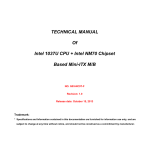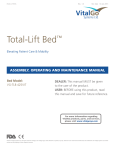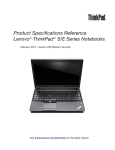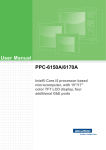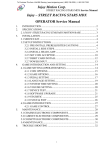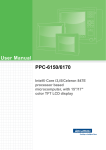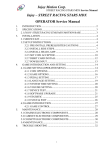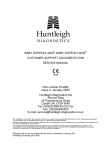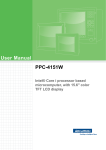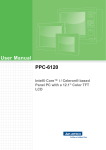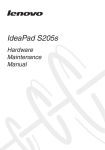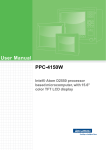Download User Manual PPC
Transcript
User Manual PPC-3100/3120 Intel® Atom Processor Based Micro-Computer with a 10.4" / 12.1" Color TFT LCD Copyright The documentation and the software included with this product are copyrighted 2013 by Advantech Co., Ltd. All rights are reserved. Advantech Co., Ltd. reserves the right to make improvements in the products described in this manual at any time without notice. No part of this manual may be reproduced, copied, translated or transmitted in any form or by any means without the prior written permission of Advantech Co., Ltd. Information provided in this manual is intended to be accurate and reliable. However, Advantech Co., Ltd. assumes no responsibility for its use, nor for any infringements of the rights of third parties, which may result from its use. Acknowledgements Intel and Pentium are trademarks of Intel Corporation. Microsoft Windows and MS-DOS are registered trademarks of Microsoft Corp. All other product names or trademarks are properties of their respective owners. Product Warranty (2 years) Advantech warrants to you, the original purchaser, that each of its products will be free from defects in materials and workmanship for two years from the date of purchase. This warranty does not apply to any products which have been repaired or altered by persons other than repair personnel authorized by Advantech, or which have been subject to misuse, abuse, accident or improper installation. Advantech assumes no liability under the terms of this warranty as a consequence of such events. Because of Advantech’s high quality-control standards and rigorous testing, most of our customers never need to use our repair service. If an Advantech product is defective, it will be repaired or replaced at no charge during the warranty period. For outof-warranty repairs, you will be billed according to the cost of replacement materials, service time and freight. Please consult your dealer for more details. If you think you have a defective product, follow these steps: 1. Collect all the information about the problem encountered. (For example, CPU speed, Advantech products used, other hardware and software used, etc.) Note anything abnormal and list any onscreen messages you get when the problem occurs. 2. Call your dealer and describe the problem. Please have your manual, product, and any helpful information readily available. 3. If your product is diagnosed as defective, obtain an RMA (return merchandize authorization) number from your dealer. This allows us to process your return more quickly. 4. Carefully pack the defective product, a fully-completed Repair and Replacement Order Card and a photocopy proof of purchase date (such as your sales receipt) in a shippable container. A product returned without proof of the purchase date is not eligible for warranty service. 5. Write the RMA number visibly on the outside of the package and ship it prepaid to your dealer. PPC-3100/3120 User Manual Part No. 200K312020 Edition 1 Printed in China October 2013 ii Declaration of Conformity CE This product has passed the CE test for environmental specifications when shielded cables are used for external wiring. We recommend the use of shielded cables. This kind of cable is available from Advantech. Please contact your local supplier for ordering information. CE This product has passed the CE test for environmental specifications. Test conditions for passing included the equipment being operated within an industrial enclosure. In order to protect the product from being damaged by ESD (Electrostatic Discharge) and EMI leakage, we strongly recommend the use of CE-compliant industrial enclosure products. FCC Class B Note: This equipment has been tested and found to comply with the limits for a Class B digital device, pursuant to part 15 of the FCC Rules. These limits are designed to provide reasonable protection against harmful interference in a residential installation. This equipment generates, uses and can radiate radio frequency energy and, if not installed and used in accordance with the instructions, may cause harmful interference to radio communications. However, there is no guarantee that interference will not occur in a particular installation. If this equipment does cause harmful interference to radio or television reception, which can be determined by turning the equipment off and on, the user is encouraged to try to correct the interference by one or more of the following measures: Reorient or relocate the receiving antenna. Increase the separation between the equipment and receiver. Connect the equipment into an outlet on a circuit different from that to which the receiver is connected. Consult the dealer or an experienced radio/TV technician for help. Technical Support and Assistance 1. 2. Visit the Advantech web site at www.advantech.com/support where you can find the latest information about the product. Contact your distributor, sales representative, or Advantech's customer service center for technical support if you need additional assistance. Please have the following information ready before you call: – Product name and serial number – Description of your peripheral attachments – Description of your software (operating system, version, application software, etc.) – A complete description of the problem – The exact wording of any error messages iii PPC-3100/3120 User Manual Safety Instructions 1. 2. 3. Read these safety instructions carefully. Keep this User Manual for later reference. Disconnect this equipment from any AC outlet before cleaning. Use a damp cloth. Do not use liquid or spray detergents for cleaning. 4. For plug-in equipment, the power outlet socket must be located near the equipment and must be easily accessible. 5. Keep this equipment away from humidity. 6. Put this equipment on a reliable surface during installation. Dropping it or letting it fall may cause damage. 7. The openings on the enclosure are for air convection. Protect the equipment from overheating. DO NOT COVER THE OPENINGS. 8. Make sure the voltage of the power source is correct before connecting the equipment to the power outlet. 9. Position the power cord so that people cannot step on it. Do not place anything over the power cord. 10. All cautions and warnings on the equipment should be noted. 11. If the equipment is not used for a long time, disconnect it from the power source to avoid damage by transient overvoltage. 12. Never pour any liquid into an opening. This may cause fire or electrical shock. 13. Never open the equipment. For safety reasons, the equipment should be opened only by qualified service personnel. If one of the following situations arises, get the equipment checked by service personnel: The power cord or plug is damaged. Liquid has penetrated into the equipment. The equipment has been exposed to moisture. The equipment does not work well, or you cannot get it to work according to the user's manual. The equipment has been dropped and damaged. The equipment has obvious signs of breakage. 14. DO NOT LEAVE THIS EQUIPMENT IN AN ENVIRONMENT WHERE THE STORAGE TEMPERATURE MAY GO BELOW -20° C (-4° F) OR ABOVE 60° C (140° F). THIS COULD DAMAGE THE EQUIPMENT. THE EQUIPMENT SHOULD BE IN A CONTROLLED ENVIRONMENT. 15. CAUTION: DANGER OF EXPLOSION IF BATTERY IS INCORRECTLY REPLACED. REPLACE ONLY WITH THE SAME OR EQUIVALENT TYPE RECOMMENDED BY THE MANUFACTURER, DISCARD USED BATTERIES ACCORDING TO THE MANUFACTURER'S INSTRUCTIONS. 16. The sound pressure level at the operator's position according to IEC 704-1:1982 is no more than 70 dB (A). DISCLAIMER: This set of instructions is given according to IEC 704-1. Advantech disclaims all responsibility for the accuracy of any statements contained herein. PPC-3100/3120 User Manual iv Safety Precaution - Static Electricity Follow these simple precautions to protect yourself from harm and the products from damage. To avoid electrical shock, always disconnect the power from your PC chassis before you work on it. Don't touch any components on the CPU card or other cards while the PC is on. Disconnect power before making any configuration changes. The sudden rush of power as you connect a jumper or install a card may damage sensitive electronic components. v PPC-3100/3120 User Manual PPC-3100/3120 User Manual vi Contents Chapter 1 Overview...............................................1 1.1 1.2 Introduction ............................................................................................... 2 Specifications ............................................................................................ 2 1.2.1 Specification Differences .............................................................. 2 1.2.2 General Specifications .................................................................. 3 1.2.3 Power Specifications..................................................................... 3 1.2.4 Touchscreen Specifications .......................................................... 3 1.2.5 Environment Specifications........................................................... 4 1.2.6 Certifications ................................................................................. 4 1.2.7 IP Grade........................................................................................ 4 Dimensions ............................................................................................... 5 Figure 1.1 PPC-3100 Dimensions (Unit: mm) ............................. 6 Figure 1.2 PPC-3120 Dimensions (Unit: mm) ............................. 7 1.3 Chapter 2 System Setup .......................................9 2.1 A Quick Tour ........................................................................................... 10 Figure 2.1 Front Panel of Panel PC........................................... 10 Figure 2.2 Side View of Panel PC ............................................. 11 Figure 2.3 IO Connectors of Panel PC ...................................... 12 Installation Procedures............................................................................ 13 2.2.1 Connecting Power Cord.............................................................. 13 Figure 2.4 Connecting Power Cord ........................................... 13 2.2.2 Connecting Keyboard and Mouse............................................... 13 2.2.3 Switching on Power .................................................................... 13 Installing Memory .................................................................................... 14 Figure 2.5 Unfastening Screws on Rear Cover ......................... 14 Figure 2.6 Unplugging Switch Wire ........................................... 14 Figure 2.7 Unfastening Heatsink Screws................................... 15 Figure 2.8 Installing Memory and Cooling Mud ......................... 15 Installing HDD ......................................................................................... 16 Figure 2.9 Removing Rear Cover .............................................. 17 Figure 2.10Removing HDD Bracket ........................................... 17 Figure 2.11Fastening HDD Screws ............................................ 18 Figure 2.12Plugging HDD Wire .................................................. 18 Installing MiniSATA ................................................................................. 19 Figure 2.13Removing HDD Bracket ........................................... 19 Figure 2.14Installing Mini SATA ................................................. 19 Installing Wireless LAN Card .................................................................. 20 Figure 2.15Installing Wireless LAN Card.................................... 20 Figure 2.16Location of Antenna.................................................. 21 Figure 2.17Installing Antenna ..................................................... 21 Installing PPC-3120-EXPE...................................................................... 22 Figure 2.18PPC-3120-EXPE Module ......................................... 22 Figure 2.19PCM-922B: 1 PCIEx and PCI................................... 22 Figure 2.20PCM-923B: PCIEx 1 and PCIEx 1............................ 23 Figure 2.21Removing Screws..................................................... 23 Figure 2.22Removing Metal Cover ............................................. 24 Figure 2.23Fixing Metal Cover.................................................... 24 Figure 2.24Installing Riser Card ................................................. 25 Figure 2.25Installing Card........................................................... 25 Figure 2.26Fixing Rear Cover..................................................... 26 Installing Hook......................................................................................... 27 Figure 2.27Installing Hook .......................................................... 27 2.2 2.3 2.4 2.5 2.6 2.7 2.8 vii PPC-3100/3120 User Manual 2.9 2.10 Chapter 3 Jumpers and Connectors................. 33 3.1 Jumpers and Connectors........................................................................ 34 Figure 3.1 Front View of PCM-8206 .......................................... 34 External COM Ports &DIO Pin Definition ................................................ 35 Figure 3.2 COM Port ................................................................. 35 3.2 Chapter Quick Installation of PPC-3120 ............................................................... 28 Figure 2.28Put Panel PC into Cabinet........................................ 28 Figure 2.29Installing PC with Clamp .......................................... 28 Figure 2.30Installing Hook.......................................................... 29 Installing Internal USB ............................................................................ 30 Figure 2.31Cable and USB Bracket ........................................... 30 Figure 2.32Fixing Bracket onto USB Connector......................... 30 Figure 2.33Removing Rear Cover.............................................. 31 Figure 2.34Removing IO Shield ................................................. 31 Figure 2.35Connecting Cable..................................................... 32 Figure 2.36Replacing IO Shield.................................................. 32 4 Software Setup.................................. 37 4.1 Driver Installation .................................................................................... 38 Figure 4.1 Drivers in CD-ROM .................................................. 38 BIOS Setup Program .............................................................................. 38 4.2.1 Entering BIOS Setup .................................................................. 38 4.2.2 Adjustment of LCD Brightness.................................................... 39 4.2.3 COM2 Mode Selection (RS232/RS422/RS485) ......................... 41 4.2.4 COM1&COM2 Pin9 Function Selection.................................... 42 4.2.5 Wake on LAN\............................................................................. 43 4.2 PPC-3100/3120 User Manual viii Chapter 1 1 Overview This chapter gives basic information of PPC-3100/3120. Sections include: Introduction Specifications Dimensions 1.1 Introduction Advantech PPC-3100/3120 is an Intel Atom processor based panel PC with a 10.4" / 12.1" color LCD display. The powerful D2550 and Intel NM10 chipsets bring the most dynamic applications to life without sacrifices to any industrial reliability. The internal mini SATA card interface can serve as an alternative HDD solution for OS booting and the mini PCI interface can be used by many expansion cards (such as a wireless LAN card) to extend device mobility.In order to satisfy customers security concerns, PPC-3100/3120 also offers 2 Giga LAN configuration. What's more, 4 serial ports and 4 USB V2.0 ports give the PPC-3100/3120 advanced versatile applications. 1.2 Specifications 1.2.1 Specification Comparison Product PPC-3100 PPC-3120 LCD Specification 10.4”LCD 12.1”LCD Display type 10.4”TFT LCD (LED backlight) 12.1”TFT LCD (LED backlight) Max. Resolution 800 x 600 1024 x 768 Supported Color 262K 262K Dot Pitch 0.264(H) x 0.264(V) 0.240(H) x 0.240(V) View Angle 80 (Left), 80 (Right) 70 (Up), 70 (Down) 80 (Left), 80 (Right) 70 (Up), 70 (Down) Luminance 400 600 Contrast Ratio 700 700 LCD Operating Temperature -20 ~ 70°C (-4 ~ 158°F) -30 ~ 80°C (-22 ~ 176°F) Backlight Life 30,000 hrs 50,000 hrs Weight 2.5 kg (5.5 lb) 3.38 kg (7.45 lb) Dimension 275 x 220 x 68 mm (10.83”x 8.74”x 2.68”) 325.00 x 253.80 x 58.40 mm (12.80” x 9.99” x 2.30”) PPC-3100/3120 User Manual 2 D2550 1.86G 1M Chipset Intel Atom D2550 + NM10 Memory 1 x 204 pin socket, up to 4 GB DDR3 SDRAM Storage 1 x 2.5”SATA HDD Network 2 x Gigabit Ethernet ports I/O Connectors 4 x COM ports: 1 x RS-232/422/485, 3 x RS232 4 x USB 2.0 interfaces 2 x Gigabit Ethernet ports 1 x VGA port, 1 x DIO port 1 x Line-out, 1 x Mic-in, 2 x 1 W speaker (Internal) 1 x Phoenix power connector, 1 x power switch Expansion Card Slots 1 x PCIe x1 (PPC-3120 Optional) 1 x PCI (PPC-3120 Optional) Additional Expansion Slots 1 x mini PCIe long card slot and 1 x mSATA card slot OS Win XP / Win 7 1.2.3 Power Specifications Product Name PPC-3100 PPC-3120 Power Consumption 25 W (Test system: Windows7 32bit) 36 W (Test system: Windows7 32bit) (D2550-NM10) 22 W (Test system: Windows XP 32bit) 34 W (Test system: Windows XP 32bit) Input Voltage 12 - 30 Vac, 5 - 2 A Note! For details about the above test conditions for power consumption, please see Remark 1 and Remark 2. 1.2.4 Touchscreen Specifications Type Five wire resistive Resolution 2048 x 2048 Light Transmission 81%+/-3% Controller COM interface Durability 36,000,000 3 PPC-3100/3120 User Manual Overview CPU Chapter 1 1.2.2 General Specifications 1.2.5 Environment Specifications Operating Temperature 0 ~ 50°C (32 ~ 122°F) Storage Temperature -20 ~ 60°C (-4 ~ 140°F) Relative Humidity 10 ~ 95% @ 40°C (Non-condensing) Shock 10 G peak acceleration (11 ms duration) Vibration 5 ~ 500 Hz 1 G RMS 1.2.6 Certifications EMC BSMI, CE, FCC Class B Safety CB, CCC, BSMI, UL 1.2.7 IP Grade Front Panel Dust-Proof & Water-Proof IP65 Remark 1: Power consumption (PPC-3100): Test Test Configuration Test System Windows 7 32bit 25 W Burn-in 7.0 Memory: Apacer DDR3 1333 SODIMM 4GBx1 HDD: Seagate ST250LT003 9YG141C-500 250GB SATA 2.5' IO: COM Port RS232 loopback x4, USB2.0 device x3, USB mouse x1 Windows XP 32bit 22 W Remark 2: Power consumption (PPC-3120): Test Test Configuration Test System Windows 7 32bit 36 W Burn-in 7.0 Memory: Apacer DDR3 1333 SODIMM 4GBx1 HDD: Seagate ST250LT003 9YG141C-500 250GB SATA 2.5' IO: COM Port RS232 loopback x4, USB2.0 device x3, USB mouse x1 Windows XP 32bit 34 W PPC-3100/3120 User Manual 4 Chapter 1 1.3 Dimensions PPC-3100: Overview 5 PPC-3100/3120 User Manual Figure 1.1 PPC-3100 Dimensions (Unit: mm) Note! Specification of mounting VESA screw: M4. Depth of screw hole: 6 mm (Max.). PPC-3120: PPC-3100/3120 User Manual 6 Chapter 1 Overview Figure 1.2 PPC-3120 Dimensions (Unit: mm) Note! Specification of mounting VESA screw: M4. Depth of screw hole: 6 mm (Max.). 7 PPC-3100/3120 User Manual PPC-3100/3120 User Manual 8 Chapter 2 2 System Setup Sections include: A Quick Tour Installation Procedures Installing Memory Installing HDD Installing Mini SATA Installing Wireless LAN Installing Expansion Card Installing Hook Quick Installation of PPC-3120 Installing Internal USB 2.1 A Quick Tour Before starting to set up the panel PC, take a moment to become familiar with the locations and purposes of controls, drivers, connectors and ports, which are illustrated in the figures below. When placed upright on the desktop, the front panel of the panel PC appears as shown in Figure 2.1. Figure 2.1 Front Panel of Panel PC 1. 2. 3. 4. Light sense indicator (Light sense) Network status indicator (LAN LED) HDD status indicator (HDD LED) Power status indicator (Power LED) Status Power On (S0) LAN LED LAN1 LAN2 Green (Operating, flashing) Yellow (Operating, flashing) PPC-3100/3120 User Manual 10 HDD LED POWER LED Yellow (Operating, flashing) Green Chapter 2 System Setup Figure 2.2 Side View of Panel PC 1. 2. 3. 4. Antenna hole CPU heatsink Hook hole for panel mount (8 holes) Speaker (left & right) 11 PPC-3100/3120 User Manual I/O connectors: Figure 2.3 IO Connectors of Panel PC A: B: C: D: E: F: G: H: Line-out / Mic-in 2 x Gigabit Ethernet ports 4 x USB 2.0 connectors DIO connector VGA connector COM1, 3, 4 RS232 connector, COM2 RS232/422/485 connector DC power connector (12 V ~ 30 V) Power switch PPC-3100/3120 User Manual 12 2.2.1 Connecting Power Cord The panel PC can only be powered through an DC electrical outlet (12 ~ 30 V). Be sure to handle the power cord by holding the plug end only. Follow these procedures to connect the power cord: 1. Connect the female end of the power cord to the DC inlet of the panel PC. 2. Connect the 3-pin male plug of the power cord to an electrical outlet. Chapter 2 2.2 Installation Procedures System Setup Figure 2.4 Connecting Power Cord 2.2.2 Connecting Keyboard and Mouse Connect the mouse and keyboard to the I/O connector of the panel PC. 2.2.3 Switching on Power The power switch is located at the lower right corner on the rear cover of the panel PC. 13 PPC-3100/3120 User Manual 2.3 Installing Memory 1. Unfasten the screws on the rear cover (8 screws). Figure 2.5 Unfastening Screws on Rear Cover 2. Unplug the switch wire from the main board and remove the rear cover. Figure 2.6 Unplugging Switch Wire PPC-3100/3120 User Manual 14 Remove the screws of the heatsink (7 screws). Chapter 2 3. System Setup Figure 2.7 Unfastening Heatsink Screws 4. Remove the heatsink and insert the memory into the right place (shown in red rectangle), and then stick the cooling mud onto it. Make sure the mud on CPU (in blue rectangle) is intact and replace the heatsink and the rear cover. Figure 2.8 Installing Memory and Cooling Mud 15 PPC-3100/3120 User Manual 2.4 Installing HDD 1. Loosen the screws shown in red rectangle. Unplug the power cord and remove the rear cover. PPC-3100/3120 User Manual 16 Chapter 2 2. Remove the green tape and unfasten the four screws to take off HDD bracket. Figure 2.10 Removing HDD Bracket 17 PPC-3100/3120 User Manual System Setup Figure 2.9 Removing Rear Cover 3. Take 4 M3x5 screws out of the accessory box. Use the screws to fix the HDD into the bracket. Figure 2.11 Fastening HDD Screws 4. Replace the HDD bracket and plug the wire. Figure 2.12 Plugging HDD Wire 5. Attach the power wire to the main board. Replace the rear cover and fix it to finish the installation. PPC-3100/3120 User Manual 18 1. Follow the above procedures to remove the HDD bracket. Chapter 2 2.5 Installing mSATA System Setup Figure 2.13 Removing HDD Bracket 2. Insert mSATA into the slot on the main board and use 2 M2.5x4 screws from the accessory box to fix it. Figure 2.14 Installing mSATA 3. Then replace the rear cover. 19 PPC-3100/3120 User Manual 2.6 Installing Wireless LAN Card 1. Follow the above procedures to take off the HDD bracket. The long wireless LAN card can be directly installed to the position shown in the below figure, while the short one needs the support of a hex bolt (in accessory box) to be fixed into the position. Figure 2.15 Installing Wireless LAN Card PPC-3100/3120 User Manual 20 Fix the antenna into the position as shown below (left & right). Chapter 2 2. System Setup Figure 2.16 Location of Antenna 3. Connect the antenna to the wireless LAN card and attach the external antenna terminals. Figure 2.17 Installing Antenna 4. Replace the HDD bracket and the rear cover to finish the installation. 21 PPC-3100/3120 User Manual 2.7 Installing PPC-3120-EXPE 1. Take PPC-3120-EXPE module out of the box. Make sure you have correct riser card to be used. Take PCM-922B as an example. Figure 2.18 PPC-3120-EXPE Module Figure 2.19 PCM-922B: 1 PCIEx and PCI PPC-3100/3120 User Manual 22 Chapter 2 2. Remove the screws on the expansion card (7 screws). Figure 2.21 Removing Screws 23 PPC-3100/3120 User Manual System Setup Figure 2.20 PCM-923B: PCIEx 1 and PCIEx 1 3. Remove the screw that fixes the metal cover onto the back of PPC-3120, and then remove the cover. Figure 2.22 Removing Metal Cover 4. Fix PPC-3120-EXPE onto the rear cover with screws (4 screws). Figure 2.23 Fixing Metal Cover PPC-3100/3120 User Manual 24 Insert the golden fingers of the riser card into the slot and use the screws to fix it (2 screws). Chapter 2 5. System Setup Figure 2.24 Installing Riser Card 6. Insert the desired card into the slot and use the screw to fix it. Card max size: L198 mm * W150 mm, component side height no more than 20 mm, the other side height no more than 5 mm. Figure 2.25 Installing Card 25 PPC-3100/3120 User Manual 7. Replace the rear cover of PPC-3120-EXPE and use the screws (7 screws) to fix it. Figure 2.26 Fixing Rear Cover PPC-3100/3120 User Manual 26 Chapter 2 2.8 Installing Hook Refer to the figure below to install the hook: How to Install Hook Plastic Tap Hook After the panel PC is installed in the cabinet, prepare the hook. Place the hook in the hole as the picture shows to hookup the panel PC. Screw Fasten the screw to fix the panel PC. Figure 2.27 Installing Hook 27 PPC-3100/3120 User Manual System Setup Use tweezers to disassemble the plastic taps on four sides of the panel PC. 2.9 Quick Installation of PPC-3120 1. Put the panel PC into the rack hole at a certain angle and make it attached to the inside of cabinet wall as shown in the below figure. Figure 2.28 Put Panel PC into Cabinet 2. Use one hand to support the PC, while use the other hand to push the PC into the cabinet by pushing up the clamp with a tool. Figure 2.29 Installing PC with Clamp PPC-3100/3120 User Manual 28 After the panel PC is attached onto the cabinet, use the hook to fix it. System Setup Figure 2.30 Installing Hook 4. If you want to remove the panel PC, reverse the above steps. 29 Chapter 2 3. PPC-3100/3120 User Manual 2.10 Installing Internal USB 1. Take out the cable and USB bracket. Figure 2.31 Cable and USB Bracket 2. Fix the bracket onto the USB connector with screws. Figure 2.32 Fixing Bracket onto USB Connector PPC-3100/3120 User Manual 30 Remove the rear cover. Chapter 2 3. System Setup Figure 2.33 Removing Rear Cover 4. Remove the IO shield. Figure 2.34 Removing IO Shield 31 PPC-3100/3120 User Manual 5. Connect the cable to the panel PC as shown in the below figure and fix the USB connector on the main board bracket. Note! Please adjust the cable in the lower left corner. Figure 2.35 Connecting Cable 6. Replace the IO shield, then the internal USB connector is ready for use. Connect the device you want to this connector and replace the rear cover. Figure 2.36 Replacing IO Shield PPC-3100/3120 User Manual 32 Chapter 3 3 Jumpers and Connectors Sections include: Jumpers and Connectors External COM Ports & DIO Pin Definition 3.1 Jumpers and Connectors Figure 3.1 Front View of PCM-8206 Connector Function CN15 LCD Size Selection JP1 Clear CMOS CN58 RS 422 120 Ω Resistor Selection (COM 2) CN15 Graphic LCD Size Selection (1-2) P1 12”LCD (PPC-3120) (3-4) P2 10”LCD (PPC-3100) P1 JP1 P2 Graphic Clear CMOS (1-3) P3 P3 Clear CMOS (3-5) P4 P4 Keep CMOS (default) P3 PPC-3100/3120 User Manual P4 34 Graphic RS 422 120 Ω Resistor Selection (COM 2) (1-2) (3-4) P6 Add 120 Ω Resistor P6 3.2 External COM Ports &DIO Pin Definition Figure 3.2 COM Port COM1: Pin9 is RI signal in COM port by default. You can also select a pin with power (5 V /12 V) (For details, please see Chapter 4.2.4) via BIOS for external device. Voltage (V) Max. Current (A) 5 V +/-10% 0.5 12 V +/-10% 0.25 COM2: The mode can be RS232/422/485, which can be selected via BIOS (For details, please see “BIOS Setup” and “COM2 Mode Selection”.) You can make PIn9 with power like COM1. DIO: 5V tolerant I/Os. 8-bit parallel input/output port. Control signal is SMBUS. 35 PPC-3100/3120 User Manual Jumpers and Connectors P5 Chapter 3 CN58 COM PORT PIN Definition Connector Function Pin RS232 RS422 RS485 1 DCD 422_TXD- 485_Data- 2 RXD 422_TXD+ 485_Data+ 3 TXD 422_RXD+ 4 DTR 422_RXD- 5 GND GND 6 DSR 7 RTS 8 CTS 9 RIC DIO PIN Definition Connector Function Pin DIO 1 GPIO0 2 GPIO1 3 GPIO2 4 GPIO3 5 GND 6 GPIO4 7 GPIO5 8 GPIO6 9 GPIO7 PPC-3100/3120 User Manual 36 Chapter 4 Software Setup Sections include: Driver Installation BIOS Setup Program 4 4.1 Driver Installation When you install the OS to panel PC for the first time, you should install the corresponding drivers to make sure all the functions will work properly. Take CD-ROM out of the accessory box and insert it into the system, you will see the following folders: Figure 4.1 Drivers in CD-ROM Windows 7: All drivers needed when installing Windows 7. Windows XP: All drivers needed when installing Windows XP. PPC Backlight Adjustment Tool: You can use this program to adjust LCD backlight to make the display effect more perfect. For detailed usages, please refer to “User manual” folder. User manual: Digital copy of the PC's user manual. Please complete the installation based on the operating system you use. The drivers in CD-ROM may not be the latest version, please get the latest ones from the below websites: http://www.advantech.com.cn/ PPC-3100/3120 User Manual 38 4.2.1 Entering BIOS Setup When the power is turned on, press <Del> button to enter BIOS setup screen. Whenever any setting is made, press <F4> to save and exit; otherwise the settings will not be saved in BIOS. Chapter 4 4.2 BIOS Setup Program Software Setup 39 PPC-3100/3120 User Manual 4.2.2 Adjustment of LCD Brightness 1. Select “Host Bridge” in “Chipset” tab. 2. Then select “Intel IGD Configuration”. PPC-3100/3120 User Manual 40 Chapter 4 A. Manual Mode “LCD Brightness Control” is set to “Manual Mode” by default, which means you should adjust the brightness by yourself. Select “Brightness Manual Control” under “Brightness Control”. There are in all six brightness levels to choose. Software Setup B. Dynamic Mode “LCD Brightness Control” is set to “Dynamic Mode”, which means LCD will automatically sense the light and adjust the brightness accordingly. 41 PPC-3100/3120 User Manual 4.2.3 COM2 Mode Selection (RS232/RS422/RS485) 1. Select “Super IO Configuration” in “Advanced” tab. 2. Select “Serial Port 2 Configuration”. You can select the mode of COM2 through “Serial Port2 Mode”. PPC-3100/3120 User Manual 42 Chapter 4 4.2.4 COM1&COM2 Pin9 Function Selection Select “Super IO Configuration” in “Advanced” tab. 2. Select the desired COM port (Serial Port 1/2 Configuration) and select the function of Pin 9 through “Serial Port1/2 Pin9 Select”. Software Setup 1. 43 PPC-3100/3120 User Manual 4.2.5 Wake on LAN\ A. Open wake on LAN function in windows 7. 1. Select “ACPI Settings” in “Advanced” tab. 2. Set “Power Saving” to “Disabled” and set “Power On by PCIE Wake#” to “Enabled”. PPC-3100/3120 User Manual 44 5. Click “Device Manager” and select “Network adapters”. Right-click the desired LAN port and select “Properties” to open “Realtek PCIe GBE Family Controller Properties” window. Software Setup Save the settings and exit OS. Right-click “Computer” to select “Manage” to open “Computer Management” window. Chapter 4 3. 4. 45 PPC-3100/3120 User Manual 6. Select “Power Management” tab in “Realtek PCIe GBE Family Controller Properties" window, then check “Allow this device to wake the computer”. B. Open wake on LAN function in windows XP. 1. Right click “Computer” and select “Manage” to enter management interface. PPC-3100/3120 User Manual 46 3. Select “Power Management”, and remember to check “Wake on Magic Packet” and “Wake on Magic Packet from power off state”. Software Setup Select “Network adapters”, and two network devices will appear. Select any device with wake on LAN function, and right click to select “Properties”. Chapter 4 2. 47 PPC-3100/3120 User Manual www.advantech.com Please verify specifications before quoting. This guide is intended for reference purposes only. All product specifications are subject to change without notice. No part of this publication may be reproduced in any form or by any means, electronic, photocopying, recording or otherwise, without prior written permission of the publisher. All brand and product names are trademarks or registered trademarks of their respective companies. © Advantech Co., Ltd. 2013
























































